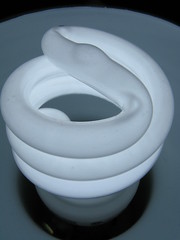We’ve probably all heard of CFLs (Compact Fluorescent Lamps) by now, and are at least vaguely aware that we should be using these things. What are they though? I think to make good choices, I need to understand what I am doing and not just do it because it’s the latest new thing. So I did some research, and here is some of the information that I found about what CFLs are, and why I made the switch in my home.
The bulbs we all grew up using are known as incandescent; this is what you are probably using if you aren’t using CFLs. This is my very non-technical explanation of how the two types of bulbs work. The traditional incandescent bulb has that squiggly looking wire thing running between two prongs. When you flip the light switch, electricity runs through the wires from the fuse box or circuit breaker, through the walls, and into the bulb, where it finally passes through the filament (the squiggly looking thing) which is then heated until it starts glowing – in the same way that the coils on an electric stove start glowing when they get heated up.
CFLs on the other hand, are a bit more complicated. The wires carry the electricity through the walls, to the bulb, but instead of creating light by heating a filament, the electricity is used to heat the inside of the bulb, which causes the mercury inside to turn from a liquid to a gas, just like liquid water evaporates when heated to a certain temperature. The mercury gas then bumps into other gas already inside the bulb, which causes a reaction between the different gas atoms that lets off ultra-violet light. The only problem is that we can’t see ultra-violet light, so that’s why the bulbs are coated with what are known as phosphors. The phosphors are compounds that emit light when exposed to light. They pick up the ultra-violet light, and then emit a kind of light that people can see.
The reason the CFLs are more efficient than incandescent bulbs is that the incandescent bulbs also emit ultraviolet light. It takes energy to generate this light, but nobody ever sees it. The CFL is making use of all of this which would otherwise be wasted. For a more technical, but very readable explanation of this see here.
So by using CFLs, you use less energy to make the same amount of light. This means you use less of whatever is used to make your energy (coal, sunlight, nuclear reactions, wind, or whatever). Because you pay for all of your energy, you save money when you use less of it.
The CFLs do cost more to purchase initially. However, according to Wikipedia’s well-sourced entry on this subject, the CFL’s will last 8 – 15 times as long as a typical incandescent bulb. The cost, they estimate ranges from 3 – 10 times the cost of an incandescent. If you factor in the longer life span and the energy savings, it seems clear to me that I’ll definitely save money in the long run, even if I purchase the bulb that lasts “only” 8 times as long as the incandescent, AND it happens to be the one that costs 10 times as much. There’s a cool little tool I found that will help you calculate your savings based on your location and usage on the bottom of this page.
The thing that I finally realized though, is that it’s not like we’re talking about buying a hybrid car versus buying a used car that gets relatively good mileage and whether this economically makes sense. We’re talking about an item that costs less than my drink of choice at Starbucks (the white chocolate mocha). What we’ve done is replace the bulbs in our home as they burn out. We avoided making a heavy investment all at once (and we took them with us when we moved!) and we’ve made the change at a pace that works for us. We’ve lived in our current location for a year now, and I have yet to replace a single light bulb – not because I’m lazy either. It’s because none have burned out.
I’d like to throw one other benefit out there. It’s a small one, but every little bit does count! If I am buying bulbs 8 – 15 times less often than I was before, I am introducing 8 – 15 times less packaging into the waste stream.
Please remember that these bulbs do contain mercury so SHOULD NEVER be thrown in the regular household trash can. There are other much better options for disposal and recycling of CFLs. If you break a bulb, you need to handle the cleanup carefully. Here’s what the EPA suggests.
All of this not-withstanding, we may not have to make the decision for much longer, as many governments are considering making the incandescent bulb as obsolete as San Francisco and China are making the plastic bag.
1 day ago












1 comment:
Your blog inspired me to stop buying bottled waters - which has been a relatively easy habit to break. And once I finish my research on light bulbs we probably will make the switch to CFLs. I do think it is important to do research on one's own and to beware jumping on the bandwagon. I prefer to be the band leader ;)
We are finally able to open the windows here in New England. It's a good day.
Post a Comment